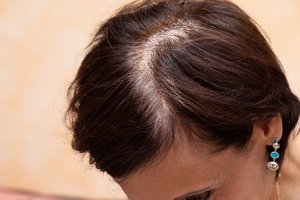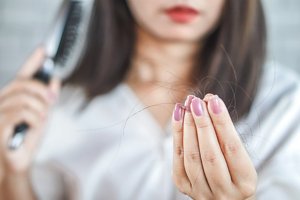GUIDE TO TACKLING HAIR LOSS
If you’ve started to notice more strands in your hairbrush or you’ve noticed your hair thinning around your temples or crown, you might be concerned about hair loss. If you think you’re losing more hair than usual, don’t panic - there’s plenty you can do to counteract hair loss and make the most of thin hair.
What causes hair loss?
Total hair loss is commonly known as alopecia, and can affect just your scalp or your whole body, including your eyebrows and eyelashes. It can be permanent or temporary, and affects both men and women. Causes include:- Hereditary hair loss - for example, if one or both of your parents started to lose their hair
- Hormonal changes, such as being postpartum or the menopause
- Medical conditions, such as Long Covid
- Medical treatments and medications, such as chemotherapy
- Behavioural habits, such as Trichotillomania, which causes suffers to pull their hair out as a response to a stressful situation
- Not washing your hair, which can cause a sebum build-up which hinders hair growth
- Ageing
- A stressful lifestyle, including a poor diet, smoking, or drinking too much alcohol
- Tying your hair back too tightly, or wearing tight hairstyles such as braids which damage your scalp and hair follicles
What are the signs of hair loss?
There’s no set guide to the symptoms of hair loss, but look out for the following:- More hair in your hairbrush, and in the shower when you wash your hair
- Noticing thinning patches of hair, which may be more noticeable under direct light overhead
- A bald spot that grows slowly
- A receding hairline on either side of your head (known as a Widow’s Peak) which grows progressively further back
- Your ponytail feels thinner
- Your hair seems to come out more easily if you gently grasp a small section of hair and very gently tug
- Your parting gets progressively wider over time

Is hair loss genetic?
Unfortunately, genetics dictate the condition of your hair as you age - and there isn’t much you can do about that. However, there are several steps you can take to minimise the impact of hair loss and slow it down, including keeping an eye on your haircare regime, stress levels, nutrition, and any medications you take.How to stop hair loss
We’d advise that you seek medical advice from your GP if you’re concerned about hair loss - they may refer you to a trichologist (a haircare expert). Bear in mind that trichology is currently not offered on the NHS, and it’s a private self-referral based service.However, there are some ways to boost hair growth which you can try:
- Scalp massage: This can improve hair growth and scalp health by improving blood flow to the scalp
- Hair growth supplements: Speak to your pharmacist about supplements to promote hair growth
- Omega supplements: Omega fatty acids are commonly found in fish oils, and can help improve your hair’s health from the inside out

Which products can help boost the thickness of thinning hair?
Our PROfiller+ range is designed to give thin, fine hair an instant boost, plumping your hair’s overall thickness by 200%* - so get ready for thicker-looking, fuller-feeling hair in just one use. The collection is infused with Biotin and Hyaluronic Acid to thicken and strengthen hair from the inside out, leaving you with increased volume and texture from your first use.- Use our thickening shampoo to help build strength - its creamy foam cleanses and rinses clean, using Bond Multiplier Technology to help strengthen fragile strands
- Smooth and hydrate with our lightweight thickening conditioner to build three-dimensional texture between your individual strands
- Apply a dab of our Strengthening Super Fluid to damp, towel-dred hair to protect and fortify hair against damage
- Finish with our thickening spray to add volume and a thicker look and feel to hair, with natural movement
- Use our hair growth scalp serum to address the signs of hair loss, improve visible hair growth and increase hair density for fuller, thicker-looking lengths.




